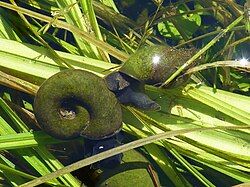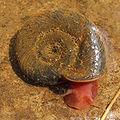Ramshorn snail
| Ramshorn snail | ||||||||||||
|---|---|---|---|---|---|---|---|---|---|---|---|---|

Planorbarius corneus |
||||||||||||
| Systematics | ||||||||||||
|
||||||||||||
| Scientific name | ||||||||||||
| Planorbarius corneus | ||||||||||||
| ( Linnaeus , 1758) |
The horn snail ( Planorbarius corneus ) is a representative of basommatophora (Basommatophora) and to the family of planorbidae expected (Planorbidae); it is not to be confused with the post squirrel genus ( Gyraulus ) belonging to the same family .
features
It has a flat trochospiral, left-hand wound housing with a diameter of up to four centimeters. It consists of 4.5 to 5 turns and is solid and thick-walled. It shows streaks of growth and occasionally clear constrictions. The body is dark brown to reddish black. After the snail dies, the empty shell takes on a chalk white color after a while.
It is the only one of the European snail species to have hemoglobin as a blood pigment and therefore red-colored blood. Due to the high oxygen affinity of hemoglobin, the ramshorn snail can survive even in very oxygen-poor waters. Although it is a lung snail, only a very small part of its breathing occurs through the intake of atmospheric air. The gas exchange predominates through the skin and a secondary gill (also called pseudo gill or auxiliary gill) located in the mantle cavity ("lung"). This secondary gill - a lobe-shaped appendix - often protrudes from the mantle cavity in active animals.

Sometimes there are albinotic animals. They lack the dark pigment melanin , so the corresponding snails have a red body due to the hemoglobin.
Reproduction
Like most water snails, the ramshorn snail is a hermaphrodite and lays its eggs in summer. The water temperature must be at least 12 ° C. The snails can fertilize each other sexually in both directions (each individual can appear both as female and male when mating), usually both individuals fertilize each other when mating. After the sexual act, a supply of semen is retained in the body of the snail, which gives off the female part, so that it can later provide for offspring, separated from other conspecifics. “Pure” self-fertilization (without a partner) is possible, but with a high mortality rate . On average, only 3% of these offspring survive. The usual, survivable reproduction takes place by crossing two specimens. The eggs are laid as flat, jelly-like clumps on the underside of the leaves of aquatic plants . The service life is up to 3 years.
Way of life and distribution
The ramshorn snail is omnivorous . It mainly feeds on algae , dead plant parts and carrion . Only when there is a lack of food does it eat living plants. The ramshorn snail is diurnal and lives in fresh water , preferably in stagnant and slowly flowing waters. The ramshorn snail hibernates in the mud. Their occurrence extends all over Europe , in the east even as far as Siberia . In northern Europe, the occurrence extends to southern Norway, southern Sweden and Finland. The saprobic index for this species is 2.0.
Aquaristic and cultivated forms
Ramshorn snails have become an integral part of the aquarium hobby. There, however, the species native to Europe was almost displaced over time by its warmth-loving and significantly smaller Californian relative Planorbella duryi . A number of hereditary colored forms, especially blue and pink ramshorn snails, are also commercially available.
Danger
The species is classified as endangered in Austria and Switzerland.
swell
literature
- Christian Albrecht, Kerstin Kuhn & Bruno Streit: A molecular phylogeny of Planorboidea (Gastropoda, Pulmonata): insights from enhanced taxon sampling. Zoologica Scripta, 36: 27-39, Oxford, 2007. doi: 10.1111 / j.1463-6409.2006.00258.x
- Peter Glöer: The animal world of Germany. Mollusca I Freshwater gastropods of Northern and Central Europe Key to identification, way of life, distribution. 2. rework. Ed., 327 pages, ConchBooks, Hackenheim 2002 ISBN 3-925919-60-0
Individual evidence
- ↑ Ewald Frömming: Biology of the Central European freshwater snails. 313 pp., Duncker & Humblot, Berlin 1956.
- ↑ EV Sodatenko & AA Petrov (2013): Mating and morphology of the copulatory apparatus in Planorbarius corneus (Linnaeus, 1758) (Gastropoda: Pulmonata). Zoosystematica Rossica, 22 (2): 153-164.
- ↑ K. Costil & J. Daguzan (1995): Self-fertilization versus cross-fertilization in two planorbid species, Planorbarius corneus (Linnaeus) and Planorbis planorbis (Linnaeus). Veliger 38 (3): 247-253.
- ↑ Meyer, Detlef .: Macroscopic biological field methods for assessing the water quality of rivers: with lists of species for beginning and experienced investigators and detailed descriptions and images of the indicator organisms . 4th, unchanged. BUND, Hannover 1990, ISBN 3-9800871-4-X .
Web links
- wirbellose.de
- Weichtiere.at - plate snails (Planorbidae): Ramshorn snail - Planorbarius corneus (Linnaeus 1758)
- Donauauen National Park - Ramshorn snail ( Planorbarius corneus )
- Fauna Europaea
- Planorbarius corneus inthe IUCN 2013 Red List of Threatened Species . Posted by: Seddon, MB & Van Damme, D., 2011. Retrieved February 12, 2014.



